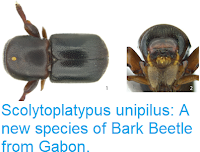The forests of West Africa are a biodiversity hotspot with over 320 Mammal and 800 Bird species, but their invertebrate fauna has been very poorly studied, with even major groups having received only cursory attention and many minor groups having been completely overlooked, somewhat of a tragedy given the threatened nature of these forests, which are rapidly declining in many areas due to logging, plantation agriculture and mining. Whip Spiders, Amblypygi, are a distinctive order of Arachnids with about 200 described species from tropical and subtropical regions around the world. They have a unique anatomy, with four pairs of legs, the front pair of which have been modified as probing sensory organs (the ‘whips’), and pedipalps (mouthparts) modified with spines that are used to trap prey in a basket-like arrangement. The Amblypygi thought to have very limited distributions, being found in caves or similar environments, while others are apparently very widespread. Like many other groups, these Arachnids have been little studied in West Africa, where to date only eight species have been described, compared to ten from Tanzania alone in East Africa.
In a paper published in the journal Evolutionary Systematics on 3 April 2018, Danilo Harms of the Zoological Museum at the University of Hamburg describes a new species of Whip Spider from the Kakum National Park in Ghana.
The Kakum Conservation Area comprises the Kakum National Park, with an area of 210 square kilometres, and the Assin Attandanso Resource Reserve, covering 150 square kilometres. These were originally created during the colonial period (1931 and 1937 respectively), in order to protect the watershed that supplied the Cape Coast region, and to provide a source of timber. Establishing forest parks for the benefit of the timber industry might seem slightly contradictory, but in Britain, the colonial power in Ghana at the time, all natural forests vanished centuries ago, and with timber coming from managed and protected woodlands harvested on a rotational basis, with trees being left to grow for decades unmolested; unprotected areas tend to be rapidly converted to arable production, which produces a crop every year. The forests at Kakum were home to a number of local communities, which relied on the forests to provide them with resources through hunting and gathering, and occasionally some artisanal gold and clay mining, but little timber harvesting is thought to have occurred before the forest parks were created.
The new species is placed in the widespread tropical genus Charinus, and given the specific name kakum, in reference to the park where it was found. The species is described from a single female specimen found brooding eggs under a flat rock on the forest floor. Like all members of the genus Charinus it is small, measuring about 5.8 mm in length. The specimen is brown in colour, with white margins on the carapace, and has six spines on its carapace behind its median eyes. It was brooding a clutch of seven large eggs, suggesting that the species has a slow reproductive cycle with high investment in each young.
The Kakum Conservation Area comprises the Kakum National Park, with an area of 210 square kilometres, and the Assin Attandanso Resource Reserve, covering 150 square kilometres. These were originally created during the colonial period (1931 and 1937 respectively), in order to protect the watershed that supplied the Cape Coast region, and to provide a source of timber. Establishing forest parks for the benefit of the timber industry might seem slightly contradictory, but in Britain, the colonial power in Ghana at the time, all natural forests vanished centuries ago, and with timber coming from managed and protected woodlands harvested on a rotational basis, with trees being left to grow for decades unmolested; unprotected areas tend to be rapidly converted to arable production, which produces a crop every year. The forests at Kakum were home to a number of local communities, which relied on the forests to provide them with resources through hunting and gathering, and occasionally some artisanal gold and clay mining, but little timber harvesting is thought to have occurred before the forest parks were created.
The new species is placed in the widespread tropical genus Charinus, and given the specific name kakum, in reference to the park where it was found. The species is described from a single female specimen found brooding eggs under a flat rock on the forest floor. Like all members of the genus Charinus it is small, measuring about 5.8 mm in length. The specimen is brown in colour, with white margins on the carapace, and has six spines on its carapace behind its median eyes. It was brooding a clutch of seven large eggs, suggesting that the species has a slow reproductive cycle with high investment in each young.
Female Charinus kakum in Dorsal View. Harms (2018).
See also...
Follow Sciency Thoughts on Facebook.







